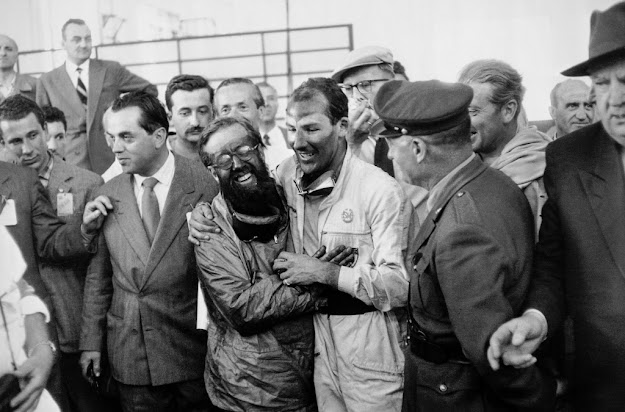 |
| Overjoyed winners Stirling Moss and Denis Jenkinson at the finishing line of the 1955 Mille Miglia. |
1 – Record time: The road book at the Mercedes-Benz Museum is not a book in the conventional sense, but a very clever solution for a concrete application: during the 1955 Mille Miglia, co-pilot Denis Jenkinson read out the detailed route information from a five-and-a-half-metre-long roll of paper in an aluminium housing with a Plexiglas window. That system allowed Stirling Moss at the wheel of the Mercedes-Benz 300 SLR racing sports car (W 196 S) to win this gruelling road race in a record time that has never been bettered.
2 – Trust: Jenkinson would hardly have been able to turn the pages of a normal book with such precision in an open car. Because the noise in the car was so loud, he passed on the meticulous route details to Moss using hand signals – Moss then put them into action with blind faith at the maximum possible speed.
3 – Predecessor: The idea of developing a race strategy based on precise knowledge of the track was not new. Czech racing driver Elisabeth Junek (1900 to 1994) is considered to be the pioneer of this analytical approach in the 1920s.
4 – Knowledge: Rally drivers call these track recordings with all the details a road book or pacenotes because, at competition level, the co-driver reads out the characteristics of the track in highly truncated note form: how fast can we go, what is the next bend like, what is the road surface like? Moss and Jenkinson meticulously gathered this knowledge during several training sessions in Italy in 1955 in preparation for the 1,600-kilometre Mille Miglia. They structured the notes according to the kilometre markers along the roads.
5 – Test phase: They used the pacenotes for the first time after Easter 1955 during training sessions. “By now, our details of the route were perfected and I now wrote them all down on a special sheet of paper eighteen feet in length. Moss had had an alloy case made, on the map-roller system, and for our final practice I employed this machine, winding the paper from the lower roller to the upper one, the notes being read through a Perspex window, sealed with Sellotape in the event of the race being run in rain.”
6 – Sign language: The code consisting of 15 hand signals proved its worth, as Stirling Moss said after the 1955 Mille Miglia: “This we agreed was a better method than any other for communication, having tried open microphones, throat ‘mikes’ and several other methods.” The reward for all their hard work was a record time of 10 hours, 7 minutes and 48 seconds, Moss and Jenkinson won the Mille Miglia at an average speed of 157.6 km/h – and nobody has managed to beat that to this day.

No comments:
Post a Comment